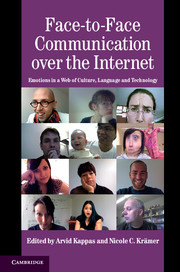Book contents
- Frontmatter
- Contents
- Preface
- Contributors
- Abbreviations
- Introduction
- Part 1 General aspects of visual cues in CMC
- Part 2 Video- and avatar-based communication
- 4 Nonverbal communication and cultural differences: issues for face-to-face communication over the internet
- 5 Video-linking emotions
- 6 Impact of social anxiety on the processing of emotional information in video-mediated interaction
- 7 Facing the future: emotion communication and the presence of others in the age of video-mediated communication
- 8 Virtual gestures: embodiment and nonverbal behavior in computer-mediated communication
- Part 3 Emotions and visual cues in HCI
- Index
- Studies in Emotion and Social Interaction
- References
5 - Video-linking emotions
Published online by Cambridge University Press: 05 June 2012
- Frontmatter
- Contents
- Preface
- Contributors
- Abbreviations
- Introduction
- Part 1 General aspects of visual cues in CMC
- Part 2 Video- and avatar-based communication
- 4 Nonverbal communication and cultural differences: issues for face-to-face communication over the internet
- 5 Video-linking emotions
- 6 Impact of social anxiety on the processing of emotional information in video-mediated interaction
- 7 Facing the future: emotion communication and the presence of others in the age of video-mediated communication
- 8 Virtual gestures: embodiment and nonverbal behavior in computer-mediated communication
- Part 3 Emotions and visual cues in HCI
- Index
- Studies in Emotion and Social Interaction
- References
Summary
Overview: How does video mediation influence communication of affective information? In the present chapter, we review the range of possible constraints associated with the video medium and consider their potential impact on transmission and coordination of emotions. In particular, we focus on the effects of transmission delays on interpersonal attunement. Results of a preliminary investigation of this issue are described. In the study, pairs of participants discussed liked and disliked celebrities via a desktop videoconferencing system. In one condition, the system was set up in its normal mode, producing a transmission delay of approximately 200 ms (high delay). In the other condition, transmission was close to instantaneous (low delay). Dependent measures included evaluative ratings of the celebrities and of the other party in the conversation and video-cued momentary codings of the interaction. Participants rated the extent of communication difficulties as greater in the normal than in the low-delay condition, but did not specifically focus on delay itself as the source of the problem. Low-delay pairs also showed greater accuracy and lower bias in their momentary ratings of attunement and involvement over the course of the conversation. Finally, there was greater convergence of affect when participants discussed mutually disliked celebrities, but greater divergence of affect when they were talking about celebrities liked by one party to the conversation but disliked by the other. […]
- Type
- Chapter
- Information
- Face-to-Face Communication over the InternetEmotions in a Web of Culture, Language, and Technology, pp. 100 - 126Publisher: Cambridge University PressPrint publication year: 2011
References
- 16
- Cited by

